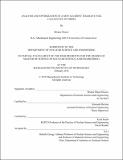| dc.contributor.advisor | Koroush Shirvan. | en_US |
| dc.contributor.author | Hiscox, Briana (Briana Diane) | en_US |
| dc.contributor.other | Massachusetts Institute of Technology. Department of Nuclear Science and Engineering. | en_US |
| dc.date.accessioned | 2018-11-15T15:52:23Z | |
| dc.date.available | 2018-11-15T15:52:23Z | |
| dc.date.copyright | 2018 | en_US |
| dc.date.issued | 2018 | en_US |
| dc.identifier.uri | http://hdl.handle.net/1721.1/119046 | |
| dc.description | Thesis: S.M., Massachusetts Institute of Technology, Department of Nuclear Science and Engineering, 2018. | en_US |
| dc.description | This electronic version was submitted by the student author. The certified thesis is available in the Institute Archives and Special Collections. | en_US |
| dc.description | Cataloged from student-submitted PDF version of thesis. | en_US |
| dc.description | Includes bibliographical references (pages 64-68). | en_US |
| dc.description.abstract | The 2011 Fukushima Daiichi accident highlighted the weakness of the current nuclear fuel and motivated R&D of accident tolerant fuels. Accident tolerant fuels (ATF) are fuels that can tolerate loss of active cooling in the core of light water reactors (LWRs) for a considerably longer period of time while maintaining or improving the fuel performance during normal operations. Fully Ceramic Microencapsulated (FCM) fuel is an ATF concept aimed at significantly increasing the fission product retention capability of nuclear fuel at high temperatures. The FCM concept is made up of fuel particles surrounded by multilayers of ceramic material similar to the TRISO fuel concept. The fuel particles are embedded in a SiC matrix in cylindrical pellet geometry which gives the fuel its high temperature corrosion resistance. However, when implementing the FCM concept in a conventional PWR fuel geometry, it is not possible to maintain an 18 month fuel cycle length and remain below the proliferation enrichment limit of 20 w/o U₂₃₅. This is a critical challenge that needs to be overcome in order to benefit from the high temperature fission product retention capability of FCM-type ATF concepts. Therefore, this work aims at investigating the potential benefits of a new accident tolerant fuel, Fuel-in-Fibers (F-in-F) concept. The Fuel-in-Fibers concept was created by Free Form Fibers, a laser chemical vapor deposition direct manufacturing company. It aims to combine the same robust fission product retention and high temperature stability as the FCM fuel concept while drastically decreasing the necessary fuel enrichment. This is done by designing a fuel fiber in cylindrical geometry as opposed to spherical particles to increase the packing fraction within a cylindrical pellet. The direct manufacturing allows for minimization of the volume occupied by the SiC matrix as well as direct deposition of high density fuels like uranium nitride (UN). Assembly level calculations in the Monte Carlo code SERPENT determined that the Fuel-in-Fibers concept could maintain a typical PWR cycle length with less than 20 w/o U₂₃₅ (LEU) enrichment. The fibers in the fuel pellet were then homogenized for use in lattice physics code CASMO and core simulator code SIMULATE3. The SIMUALTE full core simulation showed that the Fuel-in- Fibers design required enrichments of 8% and 6% for UO2 and UN as fuels, respectively. Overall, the full core analysis of a standard 4-loop Westinghouse PWR showed Fuel-in-Fibers concept has similar behavior as the conventional fuel. Due to the high fissile enrichments, the calculated radial power peaking factors were higher in Fuel-in-Fibers concept. This may result in decrease of the coolant outlet temperature by 5 K in order to maintain safety margins. The shutdown margin analysis showed that using B4C instead AgInCd control rods is needed. A design optimization was also performed to calculate the ideal geometry for Fuel-in-Fibers concept. An in-house MATLAB single channel code, built to evaluate PWR Thermal Hydraulic and Structural performance, was used to vary the fuel pin Pitch and Pitch-to-Diameter ratio (P/D Ratio). The results showed that a smaller pitch and larger diameter of 13.2 mm and 12 mm, respectively will improve the Fuel-in-Fibers concept enrichment requirements. A simplified economic analysis based on highly uncertain fabrication cost estimates was performed. The economics analysis determined that the fuel in fiber design is estimated to cost more than current UO₂ fuel by 1.25x - 15x due to the increased enrichment and fabrication costs but may be offset by the additional safety margins provided by the Fuel-in-Fibers concept. | en_US |
| dc.description.statementofresponsibility | by Briana Hiscox. | en_US |
| dc.format.extent | 76 pages | en_US |
| dc.language.iso | eng | en_US |
| dc.publisher | Massachusetts Institute of Technology | en_US |
| dc.rights | MIT theses are protected by copyright. They may be viewed, downloaded, or printed from this source but further reproduction or distribution in any format is prohibited without written permission. | en_US |
| dc.rights.uri | http://dspace.mit.edu/handle/1721.1/7582 | en_US |
| dc.subject | Nuclear Science and Engineering. | en_US |
| dc.title | Analysis and optimization of a new accident tolerant fuel called fuel-in-fibers | en_US |
| dc.type | Thesis | en_US |
| dc.description.degree | S.M. | en_US |
| dc.contributor.department | Massachusetts Institute of Technology. Department of Nuclear Science and Engineering | |
| dc.identifier.oclc | 1059518305 | en_US |
